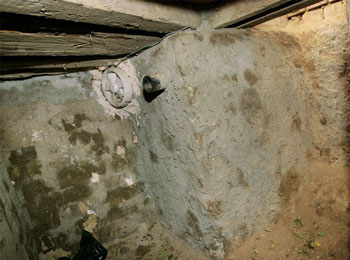 |
 |
Saddam's Spider Hole
January 2004
|
 |
|||||||||
|
Two pairs of shoes still in their boxes: A pair of clean new Hongmahwang loafers and a pair of gilded, tacky Italian slippers. The footwear of a madman caught last month hiding in a rat-filled hole almost within sight of one of his many palatial palaces. More than the beard that made him look like a character from a Harry Potter movie, more than the irony of the squalor of his final underground hiding place, it was those shoes that stopped me in my tracks and brought home to me the basic humanity of a man described for more than a year as possessing a subhuman evil. Picking through the modest compound filled with entirely pedestrian possessions, I was unprepared for the feeling that Saddam Hussein's capture gave me.
It was small, all of it. The contents of the place were strewn about, giving the single room the air of an apartment that was broken into by thieves who chose their target poorly, and frustrated with the lack of anything worth stealing decided simply to make a mess of the place.
The backyard looked like that of a small starter home somewhere where land prices are high. The courtyard, perhaps 30 feet across, was defined at the left by a small single room. The outside wall of the room was covered by an awning, like a single-auto carport. Under this was shelving, a countertop and a little four-burner propane burner. A tea kettle full of cold water sat on the stove. Basic food stuffs were strewn about: honey, sugar, corn oil, canned goods. Some Spam-like meat, in a can laced with Arabic characters. A carton of Turkish milk.
It's weird and strangely embarrassing to be face to face with the type of everyday domesticity that defines most people's lives and to realize that the person who slept in that bed, who takes honey in his tea and who gets his underwear in the same plastic-wrapped packages as any other Iraqi is synonymous with the term "brutal dictator."
For those who've lived under this man's regime, there will be no forgiveness found in this squalor -- if anything, the evidence of Saddam Hussein's modest life while he was on the run serves as an acute reminder of the vanity, avarice and oppressive authoritarianism that defined his time in power. How terrible was it? The reign of Saddam Hussein became synonymous with President Bush's "axis of evil" and his live capture and pending trial are seminal, nearly incomprehensible events for Iraqis, as much as the events of Sept. 11, 2001, were for Americans. The sight of the man emblazoned in their consciousness in countless likenesses around the country -- from posters to statues to currency -- reduced to submitting to something as humiliating as an oral exam at the hands of American soldiers, seen on televisions across Iraq, produced near epileptic displays of emotion. The jubilant stopped traffic and shot at the sky in joy: Saddam loyalists gnashed their teeth and fired rockets at U.S. military convoys. Though the celebrations weren't nearly as extensive as people expected; Baghdad was more chaotic after Saddam's sons were captured, oddly. Perhaps a certain amount of weariness and jadedness had set in by December.
After my brief tour of the room, I walked over to the the spider hole itself. The opening is rectangular and small, but carefully hewn and fringed with stone and wood. It leads down about three feet and angles another foot or two to form a T into the small narrow chamber, about eight feet long. Timbers form the roof, about a yard under the concrete slab of the courtyard above.
Gingerly, I lowered myself down into the chamber and lingered a few minutes, picturing Saddam holding his breath and listening to the sounds of American soldiers hunting him only feet away. I wondered if it ran through his mind what he'd been reduced to: hiding in a tomb with nothing between him and an invading army but a few magazines of ammunition, the parallels to Hitler's last moments inescapable. It was eerie and macabre.
I was glad to get out.
© Chris Hondros
Getty Images
|
||||||||||
|
Write a Letter to the Editor
Join our Mailing List
© The Digital Journalist
|


